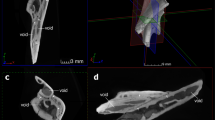Summary and conclusions
The author has studied the structure of the bony palate and its component bones in detail in three species ofUromastix : viz., U. hardwickii,U. acanthinurus andU. œgyptius. The following facts, discovered by him, are new.
-
(1)
The three species show marked differences in the anterior extension of the pterygoid, the form of the pterygo-palatine suture, the relative development of the quadrate process of the pterygoid and the relation of the pterygoid to the prevomer.
-
(2)
The pterygoid does not meet the prevomer in any species. InUromastix hardwickii, however, it shows a condition closely similar to stage R in the development ofSphenodon: a fact of great interest.
-
(3)
A process, hitherto not recorded, has been described on the ventral inner end of the transpalatine.
-
(4)
The transpalatine embraces the maxillo-jugal suture between a dorsal and a ventral process, developed at its outer end, so that the formation of the palatine foramen inUromastix differs from that of other Saurian skulls.
-
(5)
The quadrate process of the pterygoid is fully developed inUromastix œgyptius, but it does not reach quite up to the quadrate inU. hardwickii. InU. acanthinurus it reaches only up to the anterior border of the quadrate.
-
(6)
There is nocartilaginous meniscus between the pterygoid and the basipterygoid process of the basisphenoid.
-
(7)
The palatine bears a scallop-shapedprevomerine process to which the prevomer is closely applied.
Similar content being viewed by others
Literature
Bahl, K. N. “Skull ofVaranus monitor (Linn.),”Rec. Ind. Mus., 1937,39, 133–74.
Beddard, F. E. “Some notes on the cranial morphology of the mastigure lizardUromastix,”Proc. Zool. Soc, London, 1905,1, 2–9.
Beer, G. R. deThe Development of the Vertebrate Skull, Oxford, 1937.
Broom, R. “On the persistence of the mesopterygoid in certain reptilian skulls,”Proc. Zool. Soc, London, 1922, 455–60.
Busch, C. H. “Beiträge zur Kenntniss der Gaumenbildung bei den Reptilien,”Zool. Jahrb. (Anat. Abth.), 1898,11, 441–99.
El-Toubi, M. R. “The osteology of the lizardScincus scincus (Linn.),”Bull. Fac. Sci., Egypt Univ., 1938,14.
Goodrich, E. S.Studies on the Structure and Development of Vertebrates, Macmillan, 1930.
Günther, A. “Contribution to the anatomy of Hatteria (Rhynchocephalus, Owen),”Phil. Trans. Roy. Soc, London, 1867,167, 595–629.
Hoffmann, C. K. “Reptilien. II. Eidechsen und Wasserechsen,”Bronn’s Kl. u. Ordn. des Thierreichs, 1890.
Howes, G. B., and Swinnerton, H. H. “On the development of the skeleton of the Tuatara,Sphenodon punctatus; with remarks on the Egg, on the hatching, and on the hatched young,”Trans. Zool. Soc, London, 1901,16.
Sedgwick, A.A Students’ Text-book of Zoology, London, 1905,2.
Siebenrock, F. “Das Skelet der Agamidæ,”SB. K. Akad. Wiss. Wien., 1895,104, 1112.
Versluys, Jan “Kranium und Visceralskelett der Sauropsiden. I. Reptilien,”Bolk. Göppert, Kallius, u. Lubosch’s Handb. d. vergl. Anat., 1936,4.
Williston, S. W.The Osteology of Reptiles, Cambridge, 1925.
Author information
Authors and Affiliations
Additional information
Communicated by Mr. Beni Charan Mahendra
In a letter, dated February 8, 1937, Dr. Robert Mertens pointed out to me that the genus should properly be calledUromastyx (notUromastix), as that was the original spelling employed. The Rules of Nomenclature, however, state that the original orthography is to be preserved unless a typographical error, an error of transliteration, or alapsus calami is evident. As the spelling in question comes under the heading ‘of transliteration’ (Malcolm Smith in a letter to me, dated January 14, 1939), the author prefers to write ‘Uromastix’.—B. C. Mahendra.
Rights and permissions
About this article
Cite this article
Saksena, R.D. The bony palate ofUromastix Merrem. Proc. Indian Acad. Sci. 16, 107–119 (1942). https://doi.org/10.1007/BF03046949
Received:
Issue Date:
DOI: https://doi.org/10.1007/BF03046949




